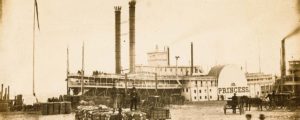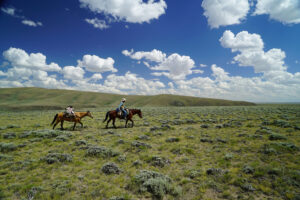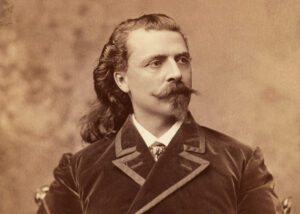Homesteaders grabbed free acres and used the earth itself to build the American dream.
They crossed the great grasslands of the United States, powered by the American dream: land, a home. When Abraham Lincoln signed the Homestead Act in 1862, pioneers were promised 160 acres, free. The condition: Live on the land and cultivate it for five years. One homesteader was a man of 24, a dreamer like the rest. In 1880, accompanying his father in a covered wagon, Solomon D. Butcher reached the heart of Nebraska, where houses were made from the very land they were planted in. It took Butcher only two weeks in a dugout camp to figure out that sodbusting was not his métier. Fortunately, he took up a novel skill he’d learned back home in Illinois. Today his quirky photographs are a unique record of the proud people who tamed the Great Plains. “We came here to this beautiful country in those early days, young, strong, healthy, filled with hope,” said one of Butcher’s subjects. “We were empire builders, the future was ours.”
Standing their ground
They put on their Sunday best for the man with the big camera, hauled out their prized possessions and mule teams and dogs and children who couldn’t hold still. In environmental portraits, Butcher colluded with his subjects to render them as they wished to be seen. His photographs have a naïf, Grandma Moses perspective, with a flat plane divided into land and sky like the landscape itself. Yet they are full of life. It was dark inside a sod house, so stoves, birdcages and watermelon feasts all gravitated to the out of doors, weather permitting. That was a boon for Butcher, who couldn’t expose his 6 1/2-by-81/2-inch glass-plate negatives indoors; photography literally means “engraving with light.” Today, using digital manipulation, Nebraska State Historical Society researchers have been able to expose hidden furniture and faces in the pictures’ dark doorways. Butcher wouldn’t have objected. He himself tampered with the visual evidence, scratching a turkey into the emulsion to conceal a flaw or re-creating historical events like the grasshopper plague below. His crude embellishments did not pretend to veracity, however. And that cow really was tethered up there.
To have and to hold
Custer County, named for the Indian fighting general, covers about 2,500 square miles, with enough streams to sustain life. By the time the first homesteaders arrived there in the 1870s, the Sioux had been driven out and the buffalo exterminated. Though the feared “Indian troubles” never materialized, the homesteaders did not coexist easily with the ranchers who were already running some 60,000 head of cattle there, and it was a lawless era. Many families, ranchers and farmers both, had each individual member file neighboring claims to protect their land—and their water. Butcher’s father, Thomas Jefferson Butcher, had the same notion, but his town-bred son gave up his claim and hightailed it out of the county before the brutal winter of 1880-81 killed off most of the cattle. By the middle of the decade there were only about 4,000 head, while the population swelled to 18,000 souls. After a flirtation with medical school in Minnesota—and a pretty nurse who became his wife—Butcher returned to Nebraska. There he built a sodwalled studio—also his young family’s home and the local post office. When business flagged, he came up with the notion of a photographic history of Custer County. If his subjects wouldn’t come to his studio, he reasoned, he would take his studio to them. It was a fresh idea at the time; a half-century later his vision of documenting ordinary Americans and their everyday lives would culminate in the work of the Depression-era photographers of the Works Progress Administration. In 1886 Butcher packed his cumbersome gear into a wagon. For nearly a decade he collected biographies and stories and made some 1,500 images, often accepting food and stabling in lieu of money for the prints he produced. “Some called me a fool, others a crank, but I was too much interested in my work to pay attention to such people,“ he said. He kept his notes and his prints in his home, where a fire destroyed them in 1899. Fortunately, the glass negatives were safe in an outbuilding, and he was able to re-create most of his work. With funding from his neighbor “Uncle Swain Finch”—who despite the grasshopper plague had become a man of substance— Butcher published his 400-page Pioneer History of Custer County in 1901. But by then the frontier days were over. He could see that the homesteaders’ way of life would not last much longer. And his fortunes were tied to theirs.
O Pioneers!
They owned the land, but it owned them too. Some 80 million acres and 1.6 million claims were made, but most homesteaders couldn’t endure the five years of hardship to get their titles. Those who prospered moved from dugouts to sod-walled palaces with shake roofs and glazed windows. And then the prairie was gone—plowed and grazed. They moved to frame houses, and soon came the automobile, the telephone, the machinery of modern life. Butcher was still a dreamer. When he didn’t make it big with his photographs, he sold his negatives to the state of Nebraska for $600 and tried land speculation, dowsing for oil and hawking patent medicines. He died in Colorado in 1927 without ever making his fortune. Nor did most settlers. Without the prairie grasses, droughts and winds tore the farmers’ livelihoods from the earth and turned everything to dust. When the 2000 census was taken, there were only 12,270 people in the county, thousands fewer than in Butcher’s day. But we inherited their trove. There are still farmhouse walls in Custer County where descendants have given these photographs pride of place. And the land is still there. Their land; our land.
Originally published in the August 2010 issue of American History. To subscribe, click here.




